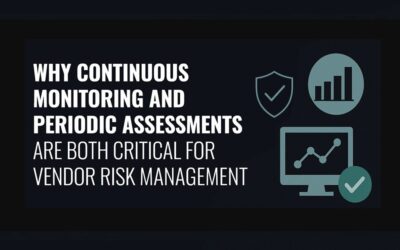The release of ChatGPT, powered by OpenAI’s advanced language model, demonstrates the power of generative AI and is changing how people think about the potential for AI to transform how we live and work. By engaging in natural and interactive conversations, ChatGPT showcases the potential for AI to comprehend and generate human-like text, blurring the line between human and machine communication. With generative AI pushing the boundaries of AI capabilities, it has become a catalyst for envisioning a world where AI seamlessly integrates into our daily lives, transforming industries, enhancing productivity, and reshaping the way we interact with technology.
Vendor risk management is a time-consuming, complex, and costly process that requires organizations to meticulously assess and mitigate potential risks associated with their vendors. Developments in generative AI have the potential to disrupt the vendor risk management process and completely reshape how we think about assessing vendor risk.
What is Deep Natural Language Processing (DNLP) and how does Generative AI impact DNLP
Deep natural language processing is when artificial intelligence is applied to understand and extract the meaning from a human inquiry to return the correct results. This technology helps machines comprehend, interpret, and respond to human languages.
Generative AI has had a significant impact on DNLP by pushing the boundaries of language understanding and generation. These models have improved the accuracy and fluency of DNLP tasks, allowing for more sophisticated language processing, translation, summarization, and even creative text generation. This synergy between generative AI and DNLP opens new possibilities for communication, automation, and personalization in various domains.
DNLP has revolutionized the document review process by automating the analysis of large volumes of text, leading to improved efficiency and accuracy. Its advanced language understanding capabilities enable the extraction of relevant information, ensuring thorough document analysis and informed decision-making within organizations.
Why Document Review is Critical to an Effective Vendor Risk Management Program
Policy documents and audits contain most, if not all, of the information that is relevant to a risk assessment, and understanding what is in these documents is critical to being able to assess and mitigate vendor risk. Currently, a vendor fills out an assessment and provides documentation that is relevant to the assessment and the organization then needs to review the documentation to ensure the accuracy, consistency, and alignment of vendors’ assessment responses with their documented policies and procedures. By thoroughly reviewing relevant documentation, organizations can validate the information provided by vendors, verify their compliance with security requirements, and assess the risks associated with engaging them. This process helps organizations make informed decisions, mitigate potential risks, and maintain a secure and trustworthy vendor ecosystem, safeguarding sensitive data and maintaining regulatory compliance.
Unfortunately, an effective document review process is becoming untenable for organizations due to the below factors:
- Costly Resource Allocation
Manual document review can be resource-intensive, requiring significant human effort and time. Hiring additional staff or outsourcing the review process can be costly for organizations, especially when dealing with large volumes of documents.
- Increasing Risk Vectors
With the growth of digitalization and interconnected systems, organizations face increasing risk vectors and are dealing with more vendors that create potential risk. On top of that, evolving regulatory requirements demand more thorough due diligence of vendors, necessitating longer and more detailed questionnaires and assessments.This results in a higher volume of documents that need to be reviewed. The sheer amount of documentation can overwhelm traditional review processes, making it challenging to identify relevant information efficiently.
- Inefficiency in Extracting Relevant Information
Documents often contain a wealth of information, but the necessary details may be scattered across lengthy text or embedded within unstructured data. Manually sifting through entire documents to extract relevant information is time-consuming and inefficient, especially when organizations only need specific insights or key data points.
How ProcessBolt AI is Transforming the Vendor Risk Management Process
ProcessBolt recently released ProcessBolt AI, a fully integrated AI-driven platform that extracts intelligence directly from vendor policy documents to populate security assessments and correlates that data with the vendor’s attack surface intelligence, taking an enormous amount of friction out of the vendor risk assessment process.
Instead of sending out long and detailed risk assessments to begin the process, vendors put all the requested policy documents and audits into the ProcessBolt platform. ProcessBolt AI then reviews all documentation using deep natural language processing and answers assessment questions, adding citations from the documentation to each question so that the enterprise can verify assessment responses. At the same time, ProcessBolt’s ThreatScape module is looking at all internet-facing attack surfaces of the vendor and correlating this data to the assessment responses, verifying that the assessment responses are consistent with attack surface data.
This innovative approach to vendor risk management reduces risk while also driving significant cost and time savings by:
- Verifying assessment responses via audits, policy documents, and attack surface data. This addresses the issue of unknown risks arising from inaccurate assessment responses as it is impossible to remediate a risk that you do not know exists.
- Eliminating the document review process, which is becoming increasingly challenging for organizations to manage. Organizations are unable to add additional resources to keep up with the increase in number of vendors being assessed and documents being collected.
- Reducing vendor fatigue. Instead of needing to fill out questionnaires with hundreds of questions, all the vendors need to do is upload their documentation and the AI completes the assessment.
With ProcessBolt AI, you can focus your time on remediating and addressing vendor risk instead of worrying about gathering and verifying the accuracy of security risk assessments.
Request a Demo
Complete this form to receive a personalized walk-through of ProcessBolt and learn how it can enhance your organization’s third-party risk management program.




